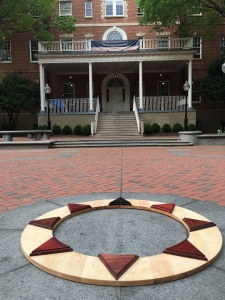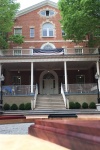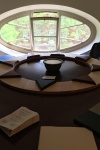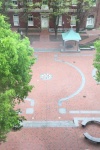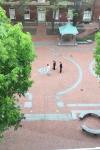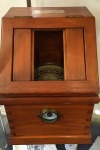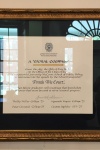This project by CCT students Maria Elena Firippis and Sam Redd was programmed with Processing and used range sensors, Raspberry Pi, and arduinos to create a visual representation of the movements of visitors to the installation. A screen flickers wildly, shifting colors and shapes as two images fight for the same digital space. The images…
Tag: CCT
Heartwood: The Moral Compass of Old North
“Heartwood: The Moral Compass of Old North” raises questions about race in the context of Georgetown as a historical institution. Here, Ken Wake, a graduate candidate in CCT, intends to explore how we understand “sacred” space in the context of a sometimes “profane” past.
For much of its history, Georgetown—like many other institutions of its age and prestige—has ignored, often actively, the fact that its current reputation is at least partially predicated on a history that includes institutional slavery. In the case of Old North, the literal foundation of the structure was built, at least in part, on the backs of slaves. Recent developments have brought this long overlooked or ignored history to the fore and have led to, among other things, the work to rededicate two buildings previous named for past university presidents involved in the sale of slaves.
In this project, the artist hopes to juxtapose the image of Old North as a highly mediated, sacred space for Georgetown—the steps from which U.S. Presidents have delivered speeches and the halls where dignitaries are often received—with the profane history of slavery that exists simultaneously in the same space. To this end, he plays with the idea of a “moral compass” by constructing a new moral compass of Old North from padauk, bubinga, and ebony—woods sourced from Western Africa, the ancestral home of many of the slaves who found their way to the Hill Top—and hard white maple—sourced from Maryland and representing the privileged white students, faculty, and staff who have benefitted from this institutional slavery.
The McCourt School of Public Policy was officially dedicated on October 8, 2013. During the Foundation Exercises for the school, Frank McCourt spoke of his wish that the students be guided by a strong moral compass during their education, careers, and life. On May 28, 2015 and in celebration of the 40th anniversary of their graduation, McCourt’s classmates donated a “moral compass” to the school, on behalf of its named benefactor.
Given Georgetown’s history and involvement with slavery, including during the construction of Old North, the idea of a “moral compass” in the context of this space seemed one needing of exploration. As a reflection on this idea, I created by hand a new “moral compass,” constructed with a base of white hard maple, from Maryland and ebony, padauk, and bubinga from Western Africa, the former home of the majority of the slaves brought to labor in the new world.
— Ken Wake
Material Timeline of Old North
On a small landing at the top of the staircase you encounter a network of wires studded with stones and shards of brick and wood. Each node has a small label specifying a date, an event, or a material. The timeline visualizes Old North’s history in relation to its material foundation. This project by CCT…
Haiku Visualized
Inspired by the haiku produced in ENGL 280, CCT students Shimeng Tong, Jiaxin Yang, and Mengya Zhou have created posters illustrating a selection of the poems. The haiku were written from observations and reflections on Old North and the space surrounding it; the posters aim to use visual design to make the haiku more accessible and create an emotional connection…
Virtual Pilgrimage
This exhibit by students Martín Mazzeo and Xi Wang uses an Oculus Rift headset to offer visitors a virtual experience of the Old North staircase as a self-contained world. The proportions and measurements of the virtual model reflect the physical dimensions of the building. But the virtual world is not the same as the one…
Window to the present
You approach a window displaying ghostly videos of unassuming faces. As you peer through the window, your presence triggers facial recognition software, which in turn records a short video of the viewer. This video is added to a rotating library which plays for the duration of the exhibit. CCT student Chris Miller used a reclaimed…
Remix: Soundtrack to Betsy Ross
This video remix by CCT student Liz Sabatiuk combines footage from the short film by Media Production students Fatima Al-Dosari and Dur Kattan with a soundtrack by Sam Redd inspired by Mosler’s painting The Birth of the Flag. Betsy Ross from Liz Sabatiuk on Vimeo.
Remix: Soundtrack to Washington Crossing the Delaware
The painting: Washington Crossing the Delaware, by Henry Mosler The soundtrack: Sam Redd, MA student in Georgetown University’s CCT Program “I began to think about the 6-7 hour crossing as the men in the painting (and not in the painting) would have experienced it. These men were cold and scared; some of them were likely…
